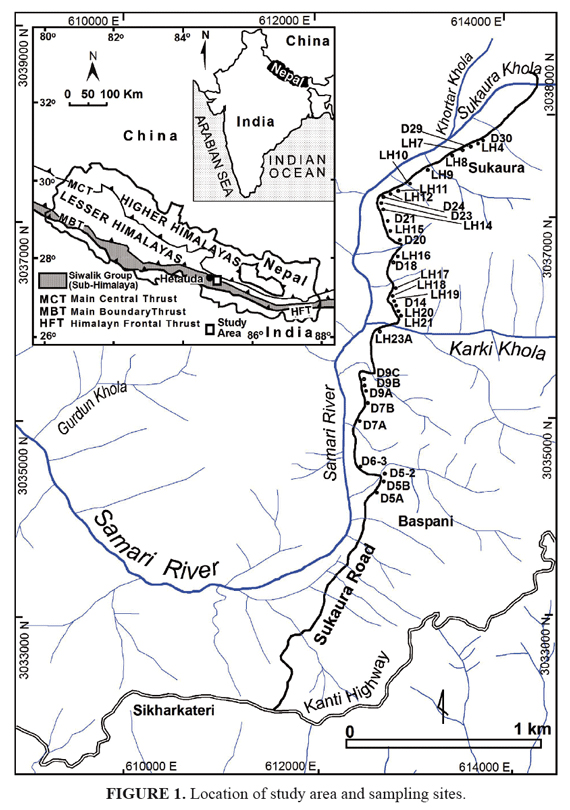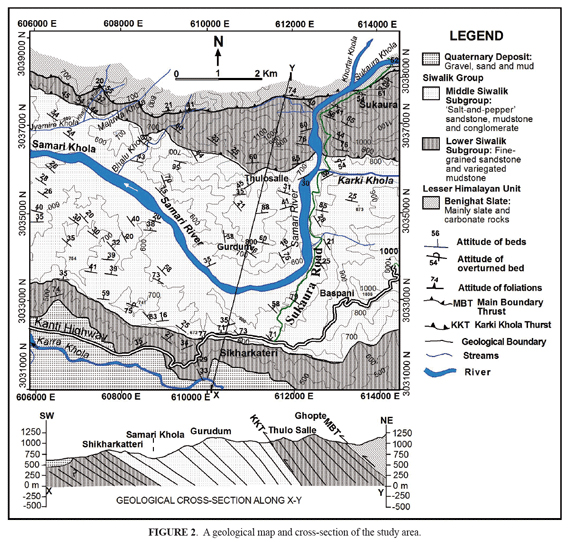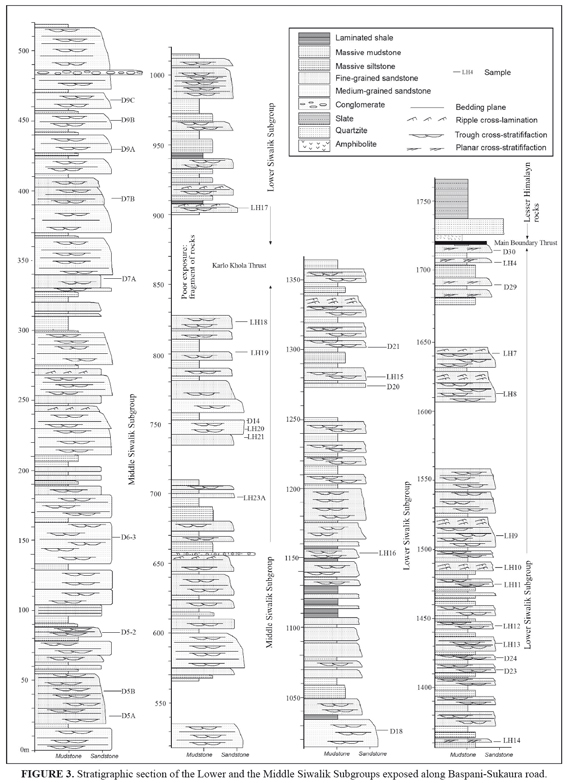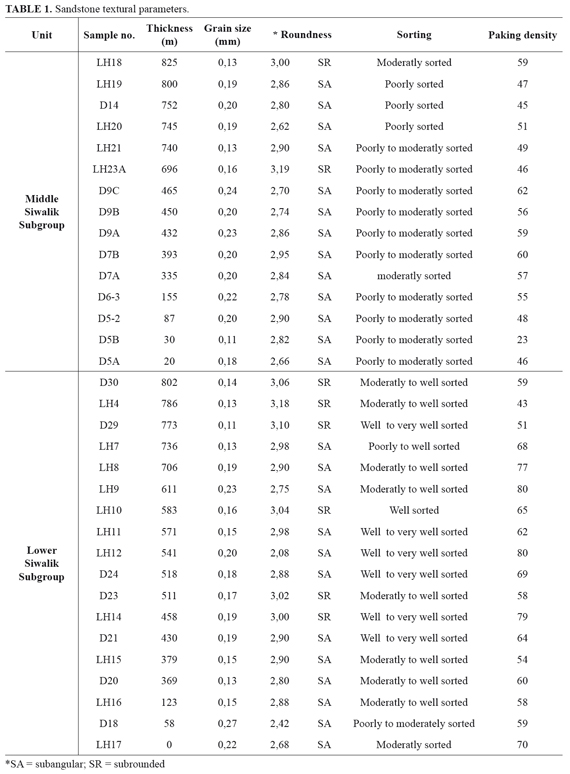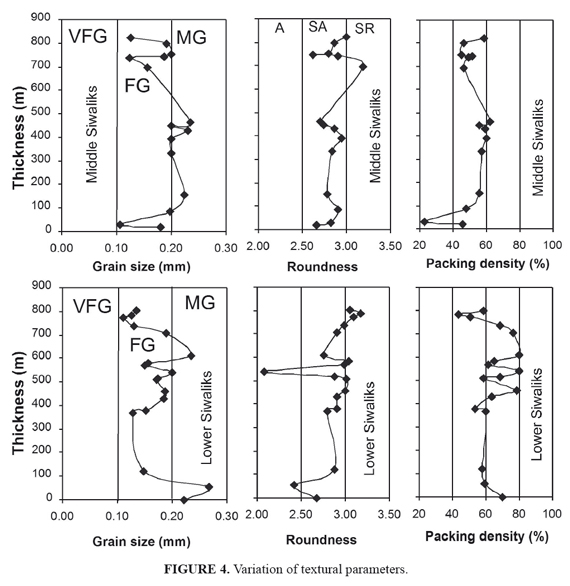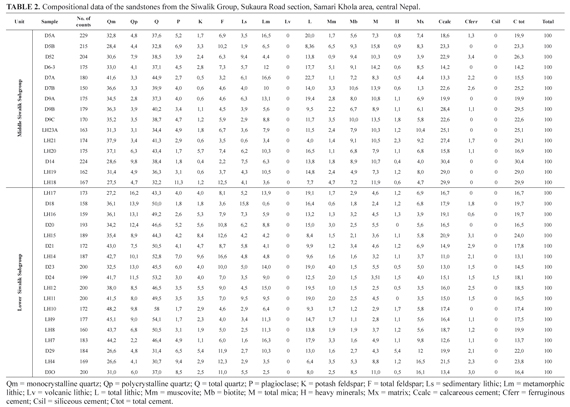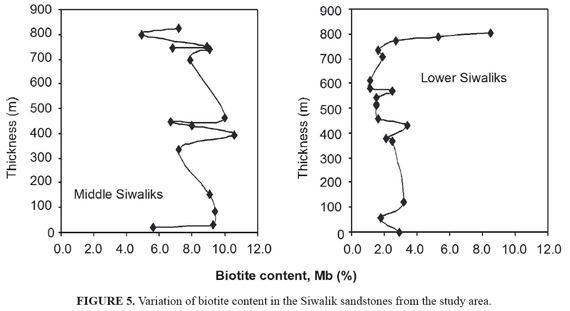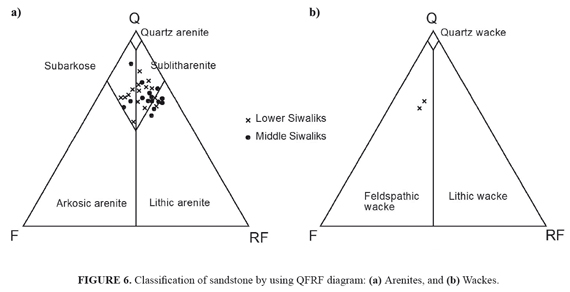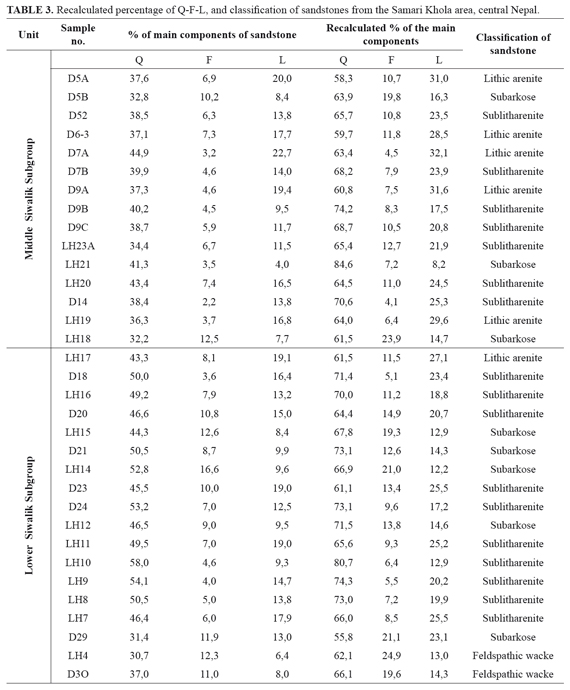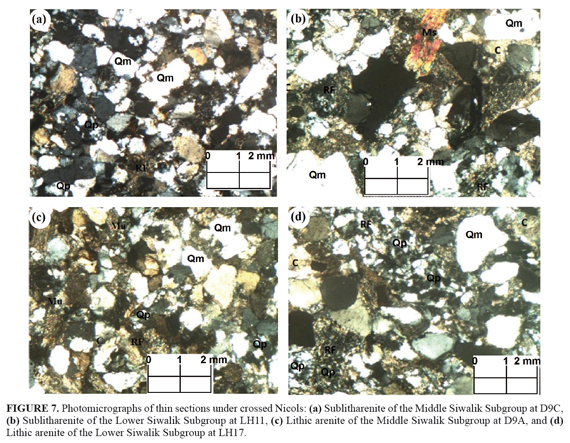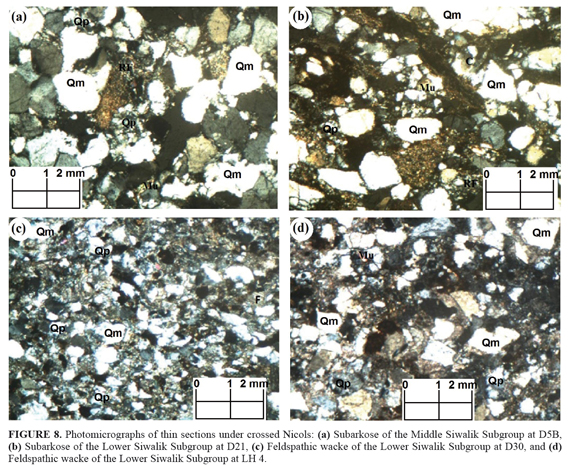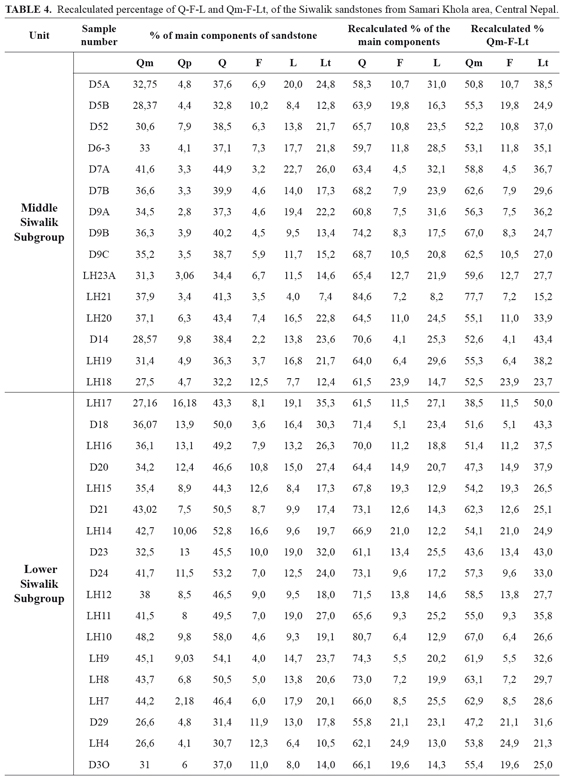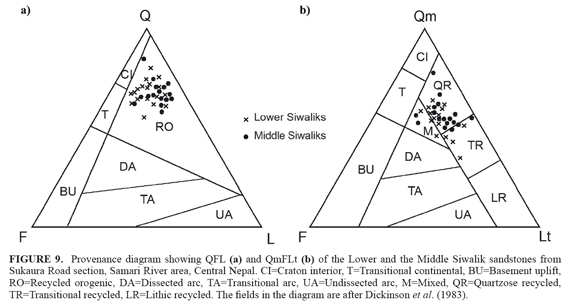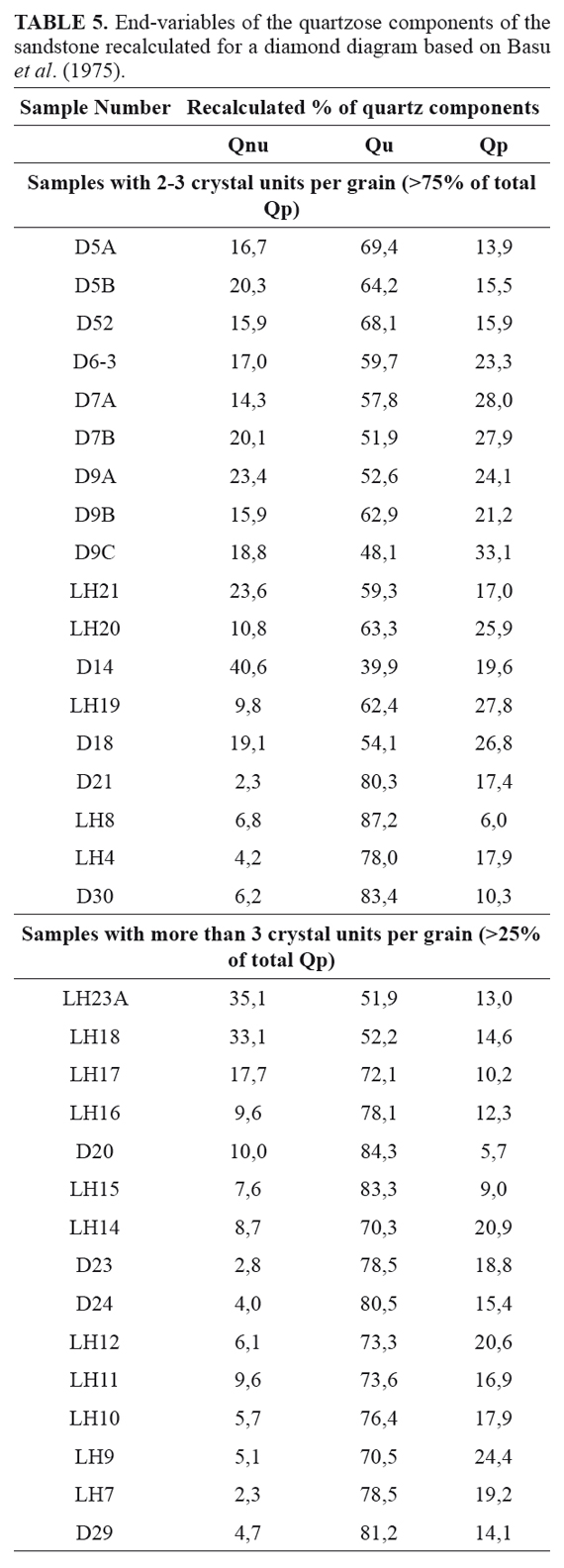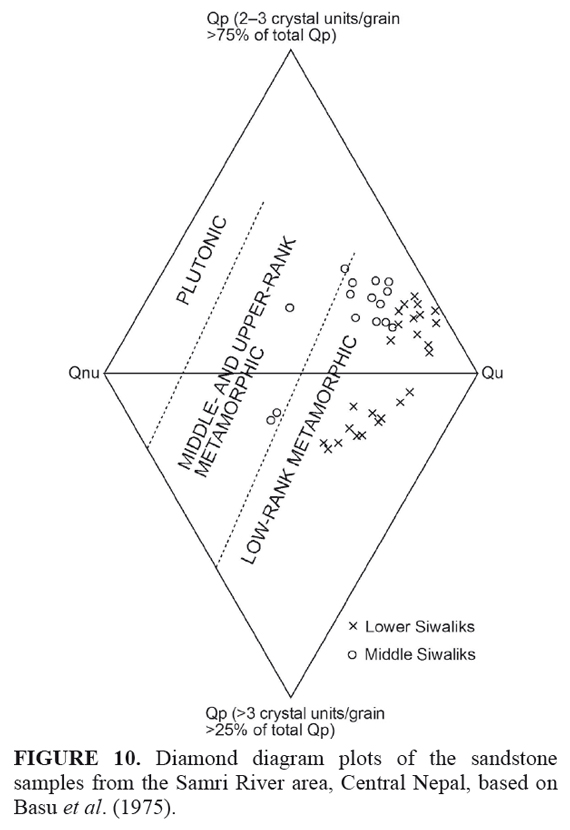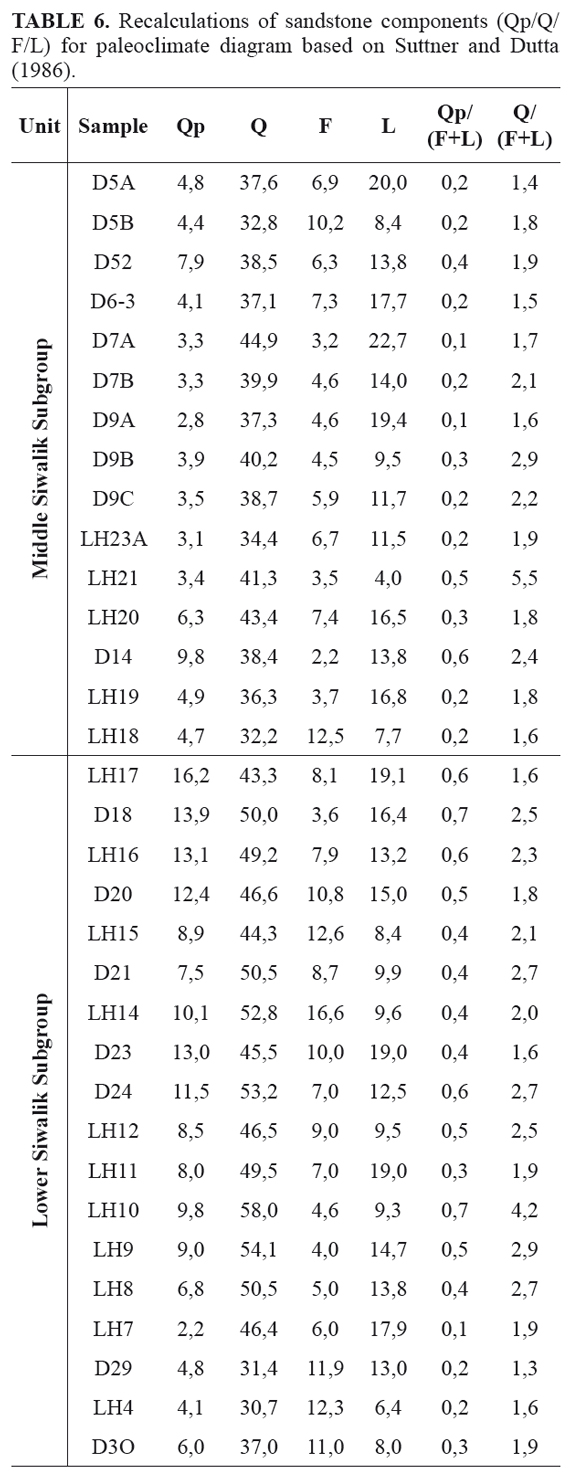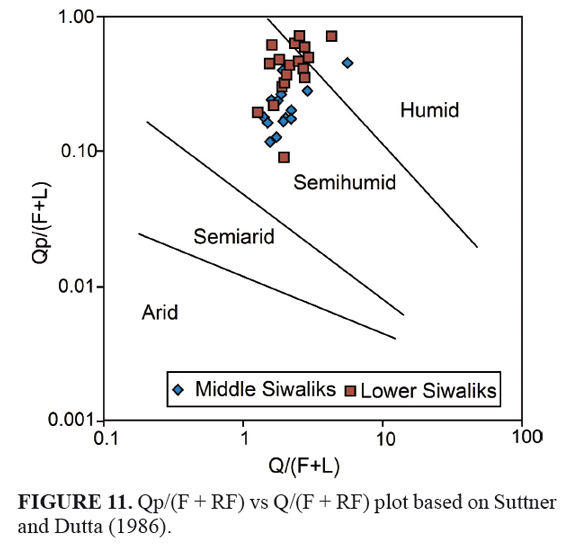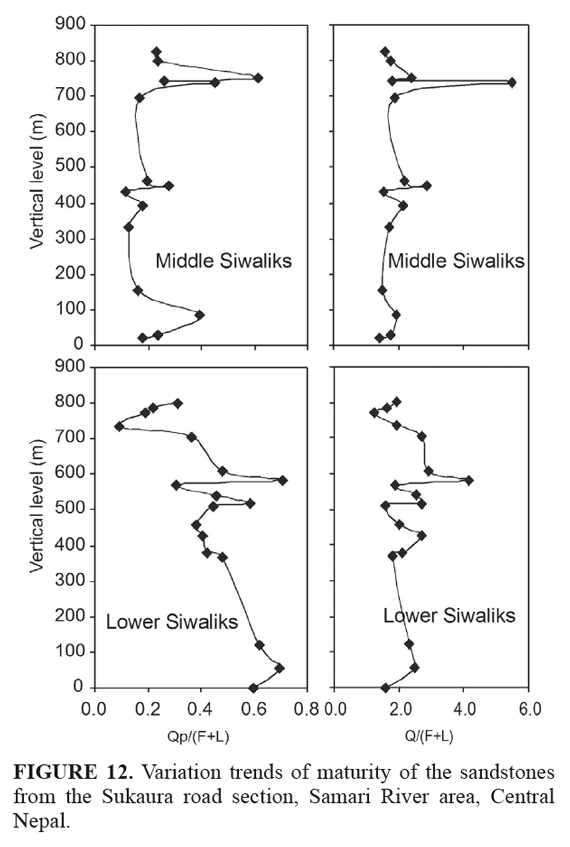Serviços Personalizados
Journal
Artigo
Indicadores
-
 Citado por SciELO
Citado por SciELO -
 Acessos
Acessos
Links relacionados
-
 Citado por Google
Citado por Google -
 Similares em
SciELO
Similares em
SciELO -
 Similares em Google
Similares em Google
Compartilhar
Boletín de Geología
versão impressa ISSN 0120-0283
bol.geol. vol.36 no.2 Bucaramanga jul./dez. 2014
SIWALIK GROUP SANDSTONES FROM THE MAIN
BOUNDARY THRUST REGION, SAMARI RIVER
AREA, CENTRAL NEPAL, SUB-HIMALAYA
Naresh Kazi Tamrakar1; Dev Kumar Syangbo1
1 Central Department of Geology, Tribhuvan University, Nepal - Kathmandu, Kirtipur, ntamrakar@hotmail.com
Suggested citation: Tamrakar, N.K., and Syangbo, D.K. 2014. Petrography and provenance of the Siwalik Group sandstones from the Main Boundary Thrust region, Samari River area, Central Nepal, sub-Himalaya. Boletín de Geología, 36 (2): 25-44.
The Siwalik Group is a thick sedimentary sequence forming the youngest mountain belt, extending throughout the East- West of the foothills of the Himalayas, and is separated from the Lesser Himalaya to the north by the Main Boundary Thrust, and the Indo-Gangetic Plain to the south by the Himalayan Frontal Thrust. The Siwalik Group was formerly the foreland basin sediment of the Himalayas. In this basin sediments were deposited during the Middle Miocene to the Early Pleistocene time by the major north to south flowing river system. Depending on the source rock lithology and tectonics, the sandstones of the Siwalik Group in different basins are found to vary in their composition and detrital constituents. The Siwalik Group in the Samari River area, Central Nepal is characterized by the exposure of the lower part of the Middle Siwalik Subgroup thrust over by the Lower Siwalik Subgroup. The sandstones of the Siwalik Group are mainly sublitharenite, lithic arenite and subarkose, and minorly feldspathic wacke. They are compositionally immature as Q/(F+L) is ≤ 2.0 and Qp/(F+L) is < 0.7. Biotite content of the Middle Siwalik sandstones (1.8%-10.6%) is higher compared to that of the Lower Siwalik sandstones (1.1%-8.5%), and reflects a high-grade metamorphic rocks source during the Middle Siwalik sedimentation. Textural maturity of the Lower Siwalik sandstones is better compared to that of the Middle Siwalik sandstones. According to the QFL and QmFLt plots on ternary diagrams, the provenance was mainly recycled orogeny during the sedimentation of the Siwalik Groups, and the source rocks were shifted from the low-grade metamorphic rocks of the Lesser Himalaya to the high-grade rocks of the Higher Himalaya. The climatic setting during the deposition of the Lower and the Middle Siwaliks was humid to semi-humid.
Keywords: Siwalik Group, sandstone, maturity, provenance
PETROGRAFÍA Y PROVENIENCIA DE LAS ARENISCAS DEL GRUPO SIWALIK
DESDE LA REGIÓN DEL LÍMITE PRINCIPAL DE CABALGAMIENTO, ÁREA DEL RÍO
SAMARI, NEPAL CENTRAL, SUB-HIMALAYA
RESUMEN
El Grupo Siwalik es una espesa secuencia sedimentaria que forma el cinturón montañoso más joven que se extiende de este a oeste por el piedemonte de Los Himalayas y que por el norte se separa del Himalaya Menor por el límite principal de cabalgamiento y por la llanura Indo- Gangética y hacia el sur por el cabalgamiento frontal del Himalaya. El Grupo Siwalik anteriormente constituyó la cuenca sedimentaria de antepaís de Los Himalayas. En esta cuenca se depositaron los sedimentos durante el Mioceno medio hasta el Pleistoceno temprano a lo largo del principal sistema de ríos con flujo norte - sur. Dependiendo de la tectónica y la litología de la roca fuente, las areniscas del Grupo Siwalik varían en las distintas cuencas en cuanto su composición y constituyentes detríticos. En el área del río Samari en Nepal Central, el Grupo Siwalik se caracteriza por la exposición de la parte inferior del Subgrupo Siwalik medio cabalgando sobre el Subgrupo del Siwalik inferior. Las areniscas del Grupo Siwalik son principalmente sublitarenitas, arenitas líticas y subarcosas, con menor proporción de wacas feldespáticas. Estas son inmaduras composicionalmente con Q/(F+L) ≤ 2,0 y Qp/(F+L) < 0,7 . El contenido de biotita de las areniscas del Siwalik medio (1,8% -10,6 %) es más alto en comparación con las del Siwalik inferior (1,1% -8,5 %) y refleja una roca fuente de metamórfitas de alto grado durante la sedimentación del Siwalik medio. La madurez textural de las areniscas del Siwalik inferior es mejor comparado con las del Siwalik medio. De acuerdo con la representación en los diagramas ternarios de QFL y QmFLt la procedencia fue principalmente de un orógeno reciclado durante la sedimentación de los grupos Siwalik, y las rocas fuente varían desde rocas metamórficas de bajo grado del Himalaya Menor hasta rocas de alto grado del Himalaya Alto. La configuración climática durante la deposición de Siwalik medio y bajo fue de húmedo a semi-húmedo.
Palabras clave: Grupo Siwalik, areniscas, madurez, procedencia
The Siwalik Group is a thick sedimentary sequence, which extends throughout the East-West of the southern Himalayan belt that represents the youngest mountain belt, and is bounded by the Main Boundary Thrust (MBT) in the north and the Himalayan Frontal Thrust (HFT) in the south (FIGURE 1), and is separated from the Lesser Himalaya in the north and the Indo Gangatic Plain in the south. The sediments of the Siwalik Group were deposited in a foreland basin of the Himalayas between the Middle Miocene and the Early Pleistocene. This foreland basin was produced by the subsequent collision of the Indian and the Eurasian plates in Eocene time during the Himalayan orogeny (Kizaki, 1994; Tokuoka et al., 1986). In Nepal, the Siwalik Group (Churia Group) extends for 800 km in length and has thickness of up to 6 km, but the thickness and lithological character are variable depending upon various factor such as size of the basin, source of sediment (Chaudhari and Gill, 1981; Tokuoka et al., 1986; Tamrakar, 1998; Critelli and Ingersoll, 1994; Kundu et al., 2012), and paleohydraulics (Nakayama and Ulak, 1999; Ulak, 2002).
The provenance of sediments incorporates aspects such as source rocks, climate, relief and hydrodynamics of environment (Pettijohn, 1984; Johnsson, 1993). Ingersoll and Suczek (1979), Dickinson et al. (1986) and Johnsson (1990) consider in tectonic setting as the most important factor of all the factors. Johnsson (1990) suggested that basic signatures of tectonic setting are not erased even by intense tropical weathering operating for a long time and variables affecting composition of sandstone are largely influenced by tectonic settings of sedimentary environments. Study of petrology and provenance of sandstone therefore provides insight into the source types, tectonic setting, and climatic regime during the time of sedimentation of the Siwalik Group sandstones. Sandstone petrology and the provenance of the Siwalik Group in the Arung Khola-Binai Khola area, west central Nepal was studied by Hisatomi (1990) who divided sandstones into three groups, namely Group 1 (quartzose arenite), Group 2 (intermediate nature or quartzo-lithic arenite), and Group 3 (lithic arenite). Petrology and provenance studies of the Siwalik Group sandstones by Critelli and Ingersoll (1994) indicated sublitharenite and lithic arenite composition of sandstones and their sources to be the Tethyan Himalayan and Lesser Himalayan zones uplifted during the India-Eurasia collision. They found in sandstones of the northwestern Pakistan, ophiolitic, volcanic lithics and radiolarian chert reflecting a provenance from the Indus suture and Trans-Himalayan belt. DeCelles et al. (1998) also found sublitharenite to lithic arenite composition of the sandstone, and found the Lesser and the Higher Himalayan zones to be the sources of the Siwalik sandstones. Tamrakar et al. (2003) classified the Siwalik sandstones of Central Nepal into sublitharenite, subarkose, lithic arenite, arkosic arenite and feldspathic greywacke. In the Eastern Himalaya of India, sandstones from the Middle Siwalik Subgroup are mostly subarkose to sublitharenite according to Kundu et al. (2012). In the Kumaon Himalayan foreland basin, Jalal and Ghosh (2012) identified the Siwalik sandstones as mostly sublitharenites. In futher western regions in India, the Siwalik sandstones are mainly lithic arenites and subordinately sublitharenites in the Dehradun subbasin and the Kangra sub-basin (Ranjan and Banerjee, 2009). These studies revealed that the sediment sources were metamorphic rocks of the Lesser Himalaya and Higher Himalaya. According to Jalal and Ghosh (2012) based on metamorphic ranking and indexing of the rock fragments in sandstones, the meta-sedimentary and very low-grade metamorphic rocks were derived from the Lesser Himalayan domain, and the medium- to high-grade metamorphic fragments were derived from the Lesser Himalayan Crystalline bodies. But based on geochemical evidence, Ranjan and Banerjee (2009) indicated the Higher Himalayan Crystalline sequence to be the primary source area with minor contributions by the meta-sedimentary succession of the Lesser Himalaya during the time of deposition of the Lower Siwalik Subgroup and the lower part of the Middle Siwalik Subgroup, whereas the provenance switched position during the sedimentation of the upper part of the Middle Siwalik and the Upper Siwalik Subgroups. Almost all these studies indicate humid climatic setting for the Siwalik sediments. Therefore, the sandstone composition and provenance vary from place to place depending on source rock lithology and tectonics.
Based on the composition of the detrital constituents in the Siwalik Group sandstones, this study is aimed to reconstruct the sediment provenance as well as to understand the tectonic evolution and climatic setting during the deposition of the Group. The study area is located in the Samari River area, central Nepal Sub-Himalaya, and is accessible by the Sukaura road (FIGURE 1).
Thirty three hand samples of sandstones were collected using selective sampling strategy along the geological traverse route, i.e., the Sukaura road (FIGURE 1) where lower part of the Middle Siwalik Subgroup and the Lower Siwalik Subgroup are exposed. The sandstones were thin-sectioned, stained for K-feldspar, and were analysed using a polarizing microscope. A petrographic study was carried out to determine texture, matrix, cement, packing density, contact type and composition of the sandstones. Mineralogical composition of the sandstones was determined by modal analyses of about 200 points counted for each thin section using Gazzi- Dickinson method (Dickinson, 1970; Ingersoll et al., 1984). Grain size was analysed and classified based on Blair and McPherson (1999) by measuring the apparent long axes of two hundred grains in each thin section. The thin- section derived sizes were corrected for sieve size using empirical equation developed by Harrell and Eriksson (1979). The roundness of 100 grains per thin-section was estimated for quartz grains using the Power's (1953) chart in which the rho-value boundary was based on Folk (1955). Packing density (PD) of the sandstone samples were calculated based on Kahn (1956). Packing density was measured as a ratio of total number of grain intercepts to the traverse length and was expressed in percentage.
The sandstones were classified based on the QFL triangle diagram of modified Dott (1964) version by Pettijohn et al. (1987). L-pole comprised lithic fragments without chert, whereas F-pole comprised only feldspar. Q-pole constituted monocrystalline quartz (Qm), polycrystalline quartz (Qp), and chert grains. Recalculated modal compositions of Q-F-L and Qm- F-Lt were plotted on triangular diagrams of Dickinson et al. (1983) for evaluating the tectonic setting. Lt-pole comprised the total lithic fragments. The source of the detrital sediments was interpreted by using the diamond shaped provenance discrimination diagram of Basu et al. (1975). For paleoclimate analysis, a bivariate loglog plot Qp/(F+L) vs Q/(F+L) after Suttner and Dutta, (1986) was made.
To the North of the Siwalik Group, there lie successively the Lesser Himalaya and Higher Himalaya which thrust over along the MBT and the MCT, respectively. The Lesser Himalaya comprises low-grade metamorphicsedimentary rocks to high grade metamorphic rocks like schist and gneiss, and plutonic rock as granite. The high-grade metamorphics and granitic intrusions are known as the Lesser Himalayan Crystalline (Stöcklin, 1981). The Higher Himalaya comprises the lower unit of high-grade metamorphic rocks (gneisses) and igneous intrusive rocks (granites), and the upper unit of the Tethys Sediments of sedimentary and metamorphic rocks mostly quartzite and carbonate rocks. Near the MBT, the Lesser Himalayan rocks are mainly of slate and carbonate rocks, but occasionally quartzite and amphibolite as found in the study area.
The Siwalik Group is divisible in to the outer and the inner zones separated by the Central Churia Thrust (CCT). The Siwalik Group itself was divided into the Lower, the Middle and the Upper Siwalik Subgroups based on lithology and increasing grain size by Auden (1935). The Lower Siwalik Subgroup is characterized by interbeddings of fine- to medium-grained sandstones and variegated mudstones forming a uniform cycles of about few meters. The Middle Siwalik Subgroup comprises medium to coarse grained, micaceous, 'salt and pepper' sandstones frequently several tens of meters thick, with interbeddings of mudstones. The Upper Siwalik Subgroup comprises pebble and cobble conglomerates often tens of meters in thickness, with interbeddings of sandstones and mud horizons. Hagen (1969), Itihara et al. (1972), Yoshida and Arita (1982), Tokuoka and Yoshida (1984), Kayastha (1979), and Bashyal et al. (1989) followed the same tripartite subdivisions of the Siwalik Group as by Auden (1935). DMG (2001) and DMG (2002) have also followed the tripartite subdivision of the Siwalik Group in its regional geological mapping of Sub-Himalaya of Nepal. Lithostratigraphy of the Amlekhganj-Hetauda area was studied by Sah et al. (1994) and that of the Bakiya River area was studied by Nakayama and Ulak (1999). They separated the Siwalik Group into the Rapti, Amlekhganj, Churia Khola and the Churia Mai Formations, from the oldest to the youngest and correlated the units to the units of the western Nepal established by Tokuoka et al. (1986). In the south of the MBT, a thrust slice of the rock unit comparable to the Lower Siwalik Subgroup, which was also mapped by DMG (2001; 2002) as the Lower Siwalik Subgroup, is observed in the study area. In the previous studies by Sah et al. (1994) and Ulak and Nakayama (1998), this unit was considered as the Middle and the Upper Members of the Amlekhganj Formation which is being equivalent to the upper part of the Middle Siwalik Subgroup and the Upper Siwalik Subgroup. Here in this study, the tripartite subdivision; Lower Siwalik, Middle Siwalik and Upper Siwalik, has been followed due to its wide acceptability throughout the Sub-Himalaya, and there is no intension of replacing the previous local subdivisions of the Siwalik units of the study area.
The present study area is located in the inner zone (northern belt) and consists of the Lower and the Middle Siwalik Subgroups only, and lacks the Upper Siwalik Subgroup. In the outer zone (southern belt) of the Siwalik Hills that lie south of the study area, however the Middle and the Upper Siwalik Subgroups are exposed from the south to the north. In the study area the Lower Siwalik Subgroup is distributed in the Sikharkateri area and the Sukaura area, while the Middle Siwalik Subgroup is exposed in Banspani-Karki Khola area (FIGURE 2). The Lower Siwalik Subgroup in the Sukaura area exists as a thrust slice, between the Karki Khola Thrust (KKT) and the MBT (FIGURE 2), the south of which is occupied by the Middle Siwalik Subgroup and the northern portion by the Lesser Himalayan rocks, Benighat Slate.
Lower Siwalik Subgroup
The Lower Siwalik Subgroup comprises mediumto very fine-grained grey sandstone and variegated mudstone showing bioturbation. The mudstone proportion exceeds that of the sandstone in the lower part and becomes subequal in the middle part while fine- to coarse-grained sandstone dominates in the upper part. The Lower Siwalik Subgroup of the Sukaura road section consists of the trough cross bedded to ripple cross-laminated, fine-grained, greenish grey to brown sandstone with subordinate greenish grey to red purple mudstone (FIGURE 3). Near the MBT, planar cross bedded, highly calcareous very fine- to fine-grained greenish grey sandstone is predominant. Variegated, greenish grey to purple mudstone and shale with numerous plant leaves and petrified wood fragments are present and show spheroidal weathering and bioturbation. Thickness of the Lower Siwalik sandstone beds varies from 0.20 to 7 m, and that of the mudstone beds approaches up to 7 m. The Lower Siwalik unit that is exposed along the Bhalu Khola (River) section consists of ripple-laminated to planar cross-bedded, fine-grained, greenish grey sandstone. The greenish grey to purple and variegated mudstone is occasionally present. Similar lithologic features are also observed near the MBT at the Jyamire Khola. Along the Kanti Highway at Sikharkateri, planar cross-bedded, finegrained and greenish grey sandstones intercalated with greenish grey to purple and variegated mudstone of the Lower Siwalik Subgroup are exposed.
Middle Siwalik Subgroup
The Middle Siwalik Subgroup comprises medium- to very coarse-grained 'salt and pepper' sandstones. 'Salt and pepper' appearance is due to the presence of biotite, quartz and feldspar grains. Trough cross-bedded, ripple laminated, medium-grained, 'salt and pepper' sandstone beds are interbedded with greenish grey to brown, spheroidally weathered mudstones (FIGURE 3). Thickness of the sandstone beds varies from 0.40 to 12 m. The Middle Siwalik rocks are exposed along the Tribhuvan Highway, Hetauda-Suparitar area, and the Jyamire Khola. In the Jyamire Khola, they are characterized by pebbly, 'salt and pepper' sandstone and sandy matrix-supported, pebbly conglomerate beds of thickness 3.5 to 5.5 m. The clasts in the conglomerate beds are mostly of quartzite, chert and vein quartz, and matrix is of dominantly quartz grains. Both clasts and matrix are bonded by calcareous cement. In the Bhalu and the Jyamire Kholas, matrix-supported, pebbly conglomerate beds with trough cross-bedded, coarseto medium-grained, grey to brown pebbly 'salt and pepper' sandstones were observed. The conglomerate beds are infrequent and of minor thickness compared to the sandstone and mudstone lithologies. Similar pebbly sandstone and sandy conglomerate beds appear in the middle and often in the upper parts of the Middle Siwalik Subgroup in the Amlekhganj area, but the sandstones present there are more thick-bedded (multistoreyed), coarser grained, and more distinctly 'salt and pepper' typed (Tamrakar et al., 2003) compared to those of the Samari River area. The Middle Siwalik rocks exposed in the Samari River area are comparable to the lower to middle parts of the Middle Siwalik Subgroup.
The Main boundary Thrust (MBT) is a steep northward dipping reverse fault which separates the Lesser Himalayan rocks to the north and the Siwalik Group to the south. The MBT (observed in the Sukaura road section) is distinguished by a significant lithological contrast between the fluvial sedimentary deposits of the Siwalik Group and the low-grade metamorphic and sedimentary rocks of the Lesser Himalaya, Benighat Slate (Stöcklin, 1981). The MBT is traced on the left bank of the Samari Khola, 100 m downstream of the confluence between the Samari Khola and the Sukaura Khola. In this area, the MBT dips towards south (190°/62°SW), and both the Siwalik rocks and the Lesser Himalayan rocks are overturned. In other areas, the attitudes of the MBT are 140°/41°NE (Bhalu Khola section) and 80°/28°NW (Jyamire Khola section). Grey black slate, amphibolite and quartzite are present on the hanging wall of the MBT. Fault gauge is present along the shear zone, while in areas other than the Sukaura road section, the MBT generally dips towards north, and is marked by the zone with breccia composed of dark grey limestone and black slate fragments.
The Karki Khola Thrust is an imbricated thrust sheet which separates the Middle Siwalik Subgroup to the south from the Lower Siwalik Subgroup to the north (FIGURE 2), and this slice extends NW-SE and dips northwards. The Karki Khola Thrust zone is characterized by the sharp contrast between massive bedded 'salt and pepper' sandstones of the Middle Siwalik Subgroup and finegrained interbedding lithology of fine-grained greenish grey sandstone and greenish grey to purple mudstone and shale. Besides, no major shear zone lithology was observed in the study area.
SANDSTONE
Texture
The results of textural parameters of sandstones are given in TABLE 1 and shown in FIGURE 4. The Lower and the Middle Siwalik samples show that the average grain sizes of sandstones range from fine- to mediumgrained. Mean roundness of quartz grains sandstone ranges from subrounded to angular categories. The Lower Siwalik sandstones contain more frequently subrounded grains compared to the Middle Siwalik sandstones. The sorting of particles in the Siwalik sandstones range from very well to very poorly sorted. The Lower Siwalik sandstones show better sorting than the Middle Siwalik sandstones do (TABLE 1). The overall decreasing of roundness and poor sorting from the Lower to the Middle Siwalik sandstones shows that the Lower Siwalik sandstones are texturally more matured compared to the Middle Siwalik sandstones.
Packing density of the Siwalik sandstones varies in wide range from 23 to 80 % (TABLE 1 and FIGURE 4). The Lower Siwalik sandstones possess higher packing density compared to the Middle Siwalik sandstones, showing that the former have experienced the greater burial depth compared to the latter. Most of the grain to grain contacts are floating to tangential in the Middle Siwalik sandstones, whereas tangential to suture contact type are dominant in the Lower Siwalik sandstones. It implies that the older sandstones have experienced higher degree of compaction and interlocking compared to the younger sandstones.
Syangbo and Tamrakar (2013) suggested the change in river systems from one of a fine-grained meandering river system during the time of deposition of the Lower Siwalik sediment to a sandy mixed-load meandering river system during the time of deposition of the Middle Siwalik sediment. This is in agreement with the results of the present analysis, i.e., the textural maturity and compositional maturity diminishes in sandstones from the Lower Siwalik to the Middle Siwalik Subgroups. Increasing of size and diminishing degrees of roundness and sorting in the Middle Siwalik sandstones reflect reduction in textural maturity. It shows rapidity of sedimentation due to change in river systems from the Lower Siwalik sedimentation phase to the Middle Siwalik sedimentation phase, perhaps caused by source rock upliftment due to thrusting of the MCT.
Composition
The modal composition of the sandstones from the Sukaura Road section is shown in TABLE 2. Modal composition shows a wide range of the compositional variation in clastic constituents. The latter includes basically quartz, feldspar and lithic fragments. Quartz grains are mono and polycrystalline varieties. Chert fragments were included in polycrystalline quartz category. Feldspars include plagioclase and K-feldspar. Lithic fragments include chert, siltstone, sandstone, phylite, schist, metasandstone, quartz-mica tectonites, quartz-mica aggregates and pelitic shale. In the sandstones, lithic fragments vary from 4 to 22%, and become less in the Lower Siwalik sandstones than in the Middle Siwalik sandstones. The average Lm in the Middle Siwalik sandstones slightly exceeds that in the Lower Siwalik sandstones. Muscovite and biotite vary from 1 to 6% in the Lower Siwalik sandstones and 1 to 10% in the Middle Siwalik sandstones, respectively. Muscovite and biotite contents are considerably low in the Lower Siwalik sandstones whereas these constituents smoothly increase towards the Middle Siwalik succession (FIGURE 5). Tokuaka et al. (1986) and Hisatomi (1990) also mentioned increase in mica content from the older to younger units of the Siwalik Group in west central Nepal.
Matrix varies from 1 to 16% of the modal composition of the sandstones. Only 2 samples have more than 15 % matrix. The amount of the matrix content is high in very fine-grained sandstone from the Lower Siwalik Subgroup. Cement content varies from 13 to 30% and the types of cementing materials are calcareous, ferruginous and siliceous. Mostly calcareous cement occurs as pore filling but some replacing cement also exists, forming reaction rims around the grains. Siliceous and ferruginous cementing materials are also seen at the boundary of the grains as syntaxial overgrowth and pressure solution. Heavy minerals range from 0 to 6%, and include opaque, garnet, zircon, kyanite, sillimanite, tourmaline, etc.
Classification and Nomenclature of sandstones
Recalculated quartz, feldspar, and lithic fragment were plotted over QFL ternary diagram of Dott (1964), modified by Pettijohn et al. (1987). The two samples with more than 15% of matrix were classified as feldspathic wacke (FIGURE 6) whereas the other samples were classified as arenites (FIGURE 6a). Arenites were further classified into subarkose, sublitharenite and lithic arenites, whereas wackes were further distinguished as felspathic wackes (TABLE 3, FIGURE 6b). The Lower Siwalik sandstones are mainly subarkoses to sublitharenites with minor feldspathic wacke and lithic arenite, whereas the Middle Siwalik sandstones are mainly sublitharenites with minor lithic arenite and subarkose.
Sublitharenite. Sublitharenites are massive, rippled to trough cross-bedded, medium-to fine-grained and calcitic cemented. Matrix varies from 3.9 to 10.4%. Quartz varies from 65.5 to 80%, feldspar from 5.5 to 14.9%, and rock fragments from 12.9 to 25.5%. They contain subangular to subrounded grains, which are poorly to moderately well sorted (FIGURES 7a and 7b). Packing density of sublitharenites from the Lower and the Middle Siwalik Subgroups reaches up to 80% and 57%, respectively. Biotite and muscovite distribution significantly increases in the Middle Siwalik sublitharenites.
Lithic arenite. Lithic arenites are massive, planar to trough cross-bedded, medium- to fine-grained, greenish grey, and are calcitic cemented. Quartz varies from 58.3 to 63.4%, feldspar from 4.5 to 11.5% and rock fragments from 27.1 to 32.1%. Matrix reaches up to 8.5%. Lithic arenites are strongly indurated with poorly to moderately sorted, subangular grains and with packing density of 46-70% (FIGURES 7c and 7d).
Subarkose. Subarkoses are massive, rippled laminated to trough cross-bedded, medium-to fine-grained, grey and are calcitic cemented (FIGURE 8a and 8b). Most of the grains are sub angular to sub rounded. They are strongly indurated with matrix varying up to 11.96%. Quartz varies from 61.5 to 71.5%, feldspar from 7.2 to 23.9%, and rock fragment from 8.2 to 16.3%. Biotite and muscovite distribution increases in the Middle Siwalik sandstones. Packing density of subarkoses ranges from 23 to 80%, and shows a decreasing trend towards the Middle Siwalik Subgroup.
Feldspathic greywacke. Feldspathic greywackes are thick, rippled laminated to planar cross-bedded, finegrained, greenish grey and are ferruginous to calcitic cemented (FIGURE 8c and 8d). They are composed of quartz 62.1-66.1%, feldspar 19.6-24.9%, lithic fragment 14%, cement 16.4-23.6% and matrix 16.5%. They are strongly indurated with sub rounded grains, and packing density of 43-59%. They are dominant mostly in the Lower Siwalik unit.
Provenance and Tectonic Setting
QFL and QFLt ternary diagrams plotted for the provenance analysis are based on triangular diagram of Dickinson et al. (1983) and Dickinson (1985). The procedure suggested by Dickinson (1985) has been carried out for defining the different components of the model analysis. Most of the plots in QFL diagram plot on recycled orogeny provenance field (TABLE 4 and FIGURE 9). The ternary diagrams (FIGURE 9) suggest transitional recycled to quartzose recycled and mixed orogeny of the Siwalik Group. The detritus of rock fragments strongly suggest mixed sources of the Siwalik sandstones as metamorphic (Lm) and sedimentary (Ls) lithics occur dominantly.
Previous studies associated the Lesser and the Higher Himalayas as probable sources for the Siwalik Group (Chaudhari, 1982; Critelli and Ingersoll, 1994; DeCelles et al., 1998; Tamrakar, 1998; Tamrakar et al., 2003). More recent study on provenance and depositional environment of the Middle Siwalik Subgroup in Eastern Himalaya, India by Kundu et al. (2012) has also shown that the sediments were derived from the Lesser and the Higher Himalayas. Ranjan and Banerjee (2009) have shown the Higher Himalayan Crystalline sequence to be the primary source of the Lower and the part of the Middle Siwalik Subgroups. The study by Jalal and Ghosh (2012) showed that the meta-sedimentary and very low-grade metamorphic rock fragments were sourced to the Lesser Himalayan domain, whereas the medium- to high-grade metamorphic fragments were sourced to the Lesser Himalayan Crystalline.
For the recognition of the sediment source and tectonic setting of the provenance, the model analysis data were plotted in a diamond diagram of the Basu et al. (1975), (TABLE 5, FIGURE 10). Frequency of the non-undulatory monocrystalline quartz (Qnu) is larger in the Middle Siwalik sandstones compared to those of the Lower Siwalik sandstones (TABLE 5). The greater abundance of Qnu may suggest plutonic provenance for the sandstones (Suttner et al., 1981). The proportions of the undulatory monocrystalline quartz (Qu) and the polycrystalline quartz (Qp) are subequal in sandstones of both Siwalik Subgroups. Basu et al. (1975) suggested that the frequency of Qp remains directly proportional to the grain size. The diamond diagram plot of the current study suggests that almost all the sandstones fall on the low-rank metamorphic provenance, i.e., sediments were transported from the low-grade metamorphic rocks of the Lesser Himalaya (FIGURE 10), however the four of the Middle Siwalik sandstones fall on the middle- and upper-rank metamorphic provenance, suggesting that the detrital grains in those sandstones were derived from highgrade metamorphic rocks from the Lesser and the Higher Himalayas. Increasing amount of muscovite and biotite content in the Middle Siwalik sandstones can be related to the unstable tectonic setting of the MCT and uplift of the Higher Himalaya. The MCT activation and the Higher Himalaya upliftment and its denudation probably had caused increase in biotite detritus to the Middle Siwalik sandstones. It suggests that the source rocks were shifted from the low-grade metamorphic rocks of the Lesser Himalaya to the High-grade rocks of the Higher Himalaya during the Lower to the Middle Siwalik sedimentation.
Paleoclimatic Setting
Paleoclimatic condition of the Lower and the Middle Siwalik Subgroups is interpreted based on the plot of the Suttner and Dutta (1986). Bivariant log-log plot of ratio of the polycrystalline quartz to feldspar plus rock fragment against ratio of total quartz to feldspar plus rock fragments (TABLE 6) is shown in FIGURE 11. All data plot mostly on semi-humid field and some on humid field of the diagram showing prevalence of these climatic conditions. Kundu et al. (2012) and Jalal and Ghosh (2012) have also suggested humid climate for the Siwalik sandstones they studied. The compositional maturity is poor; Qp/(F+L) is below 0.7 while Q/(F+L) is nearly below 4.0. Variations of Qp/(F+L) and Q/(F+L) against stratigraphic level show slightly diminishing trend of Qp/(F+L) upsection (FIGURE 12), suggesting diminishing compositional maturity towards upsection. This could have happened against the response of uplifting source areas due to thrusting and rapid sedimentation due to active river system; sandy mixedload meandering river system of the Middle Siwalik Subgroup (Syangbo and Tamrakar, 2013; Miall, 1978; Miall, 1985). Considering the abundance of the total feldspar grains, both Lower and the Middle Siwalik sandstones contain relatively low amount compared to quartz grains because of their weathering potential in humid and subhumid climates.
The Middle Siwalik sandstones are texturally and compositionally less matured compared to the Lower Siwalik sandstones. Compositionally, both Lower and Middle Siwalik sandstones are immature as Q/(F+L) is ≤ 2.0 and Qp/(F+L) is < 0.7. Textural and compositional maturities becoming lower in the Middle Siwalik sandstones compared to the Lower Siwalik sandstones perhaps reflect change in river systems, sediment derivation and sedimentation regime, and relief related to thrusting and uplifting of source areas.
The QFL and QmFLt plots on ternary diagrams reveal mainly recycled provenance and tectonic settings. The provenance shifted from low-rank metamorphic terrain to middle- and upper-rank metamorphic terrains for the Lower to the Middle Siwalik sedimentation, respectively. Biotite content and the average Lm content of the Middle Siwalik sandstones are higher compared to that of the Lower Siwalik sandstones. Increasing amount of biotite and the presence of middle to highrank metamorphic rock fragments in the Middle Siwalik sandstones reflect additional supply from high-grade metamorphic rocks during the sedimentation.
As the relative proportions of polycrystalline quartz and total quartz are exceedingly high compared to the proportion of feldspar plus lithic fragments, the climatic setting during the deposition of the Lower and the Middle Siwalik Subgroups was humid to semi-humid.
Authors are thankful to University Grant Commission for the financial support provided to MSc. Dissertation of the first author. Authors would like to thank Omar Montenegro and Rosa Carolina Ayala Calvo for critically reviewing the paper and suggesting for valuable comments.
Auden, J.B. 1935.Traverses in the Himalayan, Records of the Geological Survey of India, 69(2): 123-167. [ Links ]
Bashyal, R.P., DelCaillau, B., and Herail, G. 1989. Thrusting and orogenesis: The Himalayan Front in central Nepal. Journal of Nepal Geological Society, 6: 11-20. [ Links ]
Basu, A., Young, S.W., Suttner, L.J., James, W.C., and Mack., G.H. 1975. Re-evaluation of the use of undulatory extinction and polycrystalline in the detrital quartz for provenance interpretation. Journal of Sedimentary Petrology, 45: 873-882. [ Links ]
Blair, T.C., and McPherson, J.G. 1999. Grain size and textural classification of coarse sedimentary particles. Journal of Sedimentary Research., 69(1): 6-19. [ Links ]
Chaudhari, R.S. 1982. Petrography of the Siwalik Group of Nepal Himalaya. Recent Researches of Himalaya, 8: 424-426. [ Links ]
Chaudhari, R.S., and Gill, G.T.S. 1981. Heavy Mineral assemblage of the Siwalik Group of Nepal Himalaya. Journal of Geological Society of India, 22: 220-226. [ Links ]
Critelli. S., and Ingersoll, R.V. 1994. Sandstone petrology and provenance of the Siwalik Group (northwest Pakistan and western southeastern Nepal). Journal of Sedimentary Research, 64: 815-823. [ Links ]
DeCelles, P.G., Gehrels, G.E., Quade, J., Ojha, T.P., Kapp, P.A., and Upreti, B.N. 1998. Neogene foreland basin deposits erosional unroofing and the kinematic history of the Himalayan fold-thrust belt, western Nepal. Geological Society of America Bulletin, 110: 2-21. [ Links ]
Dickinson, W.R. 1970. Interpreting detrital modes of graywacke and arkose. Journal of Sedimentary Petrology, 40: 695-707. [ Links ]
Dickinson, W.R. 1985. Interpreting provenance from detrital modes of sandstones. In: Provenance of arenites (Zuffa, G.G., North Atlantic Treaty Organization, Advance science institution series 148. Ed). Reidel publishing Co., Dordrecht, pp. 333-361. [ Links ]
Dickinson, W.R., Lawton, T.F., and Inman, K.F. 1986. Sandstone detrital modes, central Utah Foreland region: Stratigraphic record of Cretaceous-Paleogene tectonic evolution. Journal of Sedimentary Petrology, 56 (2): 276-293. [ Links ]
Dickinson, W.R., Beard, L. S., Brakenridge, G.R., Erjavec, J.L., Ferguson, R.C., Inman, K.F., Knepp, R.A., Lindberg, F.A., and Ryberg, P.T. 1983. Provenance of North American Phanerozoic sandstones in relation to tectonic setting. Geological Society of America Bulletin, 94: 222-235. [ Links ]
DMG. 2001. Geological map of Sub-Himalaya, central Nepal. Scale 1:63000. Petroleum exploration promotion project, DMG (Department of Mines and Geology). [ Links ]
DMG. 2002. Geological map of Sub-Himalaya, central Nepal. Scale 1:63000. Petroleum exploration promotion project, DMG (Department of Mines and Geology). [ Links ]
Dott, R.H. 1964. Wacke, greywacke and matrix-what approach to immature sandstone classification. Journal of Sedimentary Petrology, 55: 691-704. [ Links ]
Folk, R.I. 1955. Student operator error in determination of roundness, sphericity, and grain size. Journal of Sedimentary Petrology, 25: 297-301. [ Links ]
Hagen, T. 1969. Report of the geological survey of Nepal. Vol. 1. Denkschr Schweiz. Naturef, Gesell, 86 (1): 185. [ Links ]
Harrell, J.A., and Eriksson, K.A. 1979. Empirical conversion Equation for thin-section and sieve derived size distribution parameters. Journal of Sedimentary Petrology, 49: 273-280. [ Links ]
Hisatomi, K. 1990. The sandstone petrology and the provenance of the Churia Group in the Arung Khola - Binai Khola area, west central Nepal. Bulletin Faculty of Education, Wakayama Univ. Nat. Sci., 39: 5-29. [ Links ]
Ingersoll, R.V., and Suczek, C.A. 1979. Petrology and provenance of Neogene sand from Nicobar and Bengal Fans, DSDP sites, 211 and 218. Journal of Sedimentary Petrology, 49 (4): 1217-1228. [ Links ]
Ingersoll, R.V., Bullard, T.F., Ford, R.L., Grimm, J.P., Pickle, J.D., and Sars, S.W. 1984. The effect of grain size on detrital modes: a test of the Gazzi-Dickinson pointcounting method. Journal of Sedimentary Petrology, 54 (1): 103-116. [ Links ]
Itihara, M., Shibasaki, T., and Miyamoto, N. 1972. Photogeological survey of the Siwalik Ranges and the Terai Plain southeastern Nepal. Journal of Geosciences of Osaka City University, 15: 77-98. [ Links ]
Jalal, P., and Ghosh, S.K. 2012. Provenance of the Late Neogene Siwalik sandstone, Kumaun Himalaya Foreland Basin: Constrains from the metamorphic rank and index of detrital rock fragments. Journal of Earth System Science, 121(3): 781-792. [ Links ]
Johnsson, M.J. 1990. Tectonic versus chemicalweathering controls on the composition of fluvial sands in tropical environments. Sedimentology, 37: 713-116. [ Links ]
Johnsson, M.J. 1993. The system controlling the composition of clastic sediments. In: Processes controlling the composition of clastic sediments (Johnsson, M.J., and Basu, A. Eds.), Geological Society of America Special Papers, 284, pp. 1-19. [ Links ]
Kahn, J.S. 1956. The analysis and distribution of the properties of packing in sand-size sediments. 1. On the measurement of packing in sandstone. Journal of Geology, 64: 385-395. [ Links ]
Kayastha, N.B. 1979. Report on Geology of Kailali- Kanchanpur Area, Far Western Nepal. Department of Mines and Geology, Kathmandu (unpub. Rep.), pp.27. [ Links ]
Kizaki, K. 1994. An Outline of Himalayan Upheaval. Jagadamba, Kathmandu, pp. 127 [ Links ]
Kundu, A., Matin, A. and Mukul, M. 2012. Depositional environment and provenance of Middle Siwalik sediments in Tista valley, Darjiling District, Eastern Himalaya, India. Journal of Earth System Science, 121(1): 73-89. [ Links ]
Miall. A.D. 1985. Architectural-element analysis: a new method of facies analysis applied to fluvial deposits. Earth Science Reviews, 22: 261- 308. [ Links ]
Miall, A.D. 1978. Lithofacies types and vertical profile models in braided river deposit: a summary. In: Fluvial Sedimentology (Miall A.D. Ed.). Canadian Society of Petroleum Geologists, pp 597-904. [ Links ]
Nakayama, K., and Ulak, P.D. 1999. Evolution of fluvial style in the Siwalik Group in the foothills of the Nepal Himalaya, Journal of Sedimentary Geology, 152: 205-224. [ Links ]
Pettijohn, F.J. 1984. Sedimentary Rocks, Third edition, CBS Publishers. New Delhi, 628p. [ Links ]
Pettijohn, F. J., Potter, P. E., and Siever, R. 1987. Sand and Sandstone. Second edition. Springer -Verlag. New York Inc. New York. 553p. [ Links ]
Powers, M.C. 1953. A new roundness scale for sedimentary particles. Journal of Sedimentary Geology, 23: 177-119. [ Links ]
Ranjan, N., and Banerjee, D.M. 2009. Centtral Himalayan crystallines as the primary source for the sandstonemudstone suites of the Siwalik Group: New geochemical evidence. Gondwana Research, 16: 687-696. [ Links ]
Sah, R.B., Ulak, P.D., Gajurel, A.P., and Rimal, L.N. 1994. Lithostratigraghy of Siwalik Sediments of Amlekhganj- Hetauda area, Sub- Himalaya of Nepal. Himalayan Geology, 15: 37-38. [ Links ]
Stöcklin, J. 1981. Geology of the Nepal and its Regional Frame: Journal of the Geological Society of London, 137: 1-34. [ Links ]
Suttner, L.J., and Dutta, P.K. 1986. Alluvial sandstone composition and paleoclimate. 1. Framework mineralogy. Journal of Sedimentary Petrology, 56: 329-345. [ Links ]
Suttner, L.J., Basu A., and Mack, G.H. 1981. Climate and the origin of quartz arenite. Journal of Sedimentary Petrology, 51: 1235-1244. [ Links ]
Syangbo, D.K., and Tamrakar N.K. 2013. Lithofacies and depositional environment of the Siwalik Group in Samari-Sukaura River area, Central Nepal. Bulletin of the Department of Geology. Tribhuvan University, 16: 53-64. [ Links ]
Tamrakar, N.K. 1998. Some Diagenetic Characteristics of Arenites from the Siwaliks, Surai Khola Area, Mid Western Nepal. Bulletin of the Department of Geology. Tribhuvan University, 6: 89-98. [ Links ]
Tamrakar, N.K., Yokota, S., and Shrestha, S.D. 2003. Petrography of the Siwalik sandstones, Amlekhganj- Suparitar area, central Nepal Himalaya. Journal of Nepal Geological Society, 28: 41-56. [ Links ]
Tokuoka, T., and Yoshida, M. 1984. Some characteristics of the Siwalik (Churia) Group in the Chitwan Dun, central Nepal. Journal of Nepal Geological Society, 4: 63-72. [ Links ]
Tokuoka. T., Takayasu, K., Yoshida, M., Hisatomi, K. 1986. The Churia (Siwalik) Group in the Western part of the Arun Khola area, West Central Nepal. Mem. Fac. Shim. Univ., 22: 131-143. [ Links ]
Ulak, P.D., and Nakayama, K. 1998. Lithostratigraphy and evolution of fluvial style of the Siwalik Group in the Hetauda-Bakiya Khola area, central Nepal. Bulletin of the Department of Geology. Tribhuvan University, 6: 1-14. [ Links ]
Ulak, P.D. 2002. Paleohydrology of the Siwalik Group along the Bakiya Khola section central Nepal Himalaya. Journal of Nepal Geological Society, 256: 49-58. [ Links ]
West, R.M. 1984. Siwalik faunas from Nepal: Paleoecologic and Paleoclimatic implications. In: The evolution of the east Asian environment Centre of Asian Studies. Vol. 2. (Whyte, R.O. Ed.). University of Hongkong, pp. 724-744. [ Links ]
Yoshida, M., and Arita, K. 1982. On the Siwaliks observed along some routes in Central Nepal. Journal of Nepal Geological Society, 2: 59-66. [ Links ]
Received: 17 October 2013
Accepted: 25 April 2014













